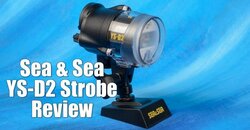Long a major manufacturer of high-quality underwater strobes, Sea & Sea turned the world on it’s ear a few years ago with the introduction of the YS-D1 underwater strobe. Small, very powerful and adjustable, it's become a standard for many photographers. Recently Sea & Sea released a revised YS-D2 strobe model...
There were annoyances with the YS-D1. Small switch dial knobs on the back were easily knocked to the wrong position if you grabbed the back of the strobe. It was hard to tell what mode you were in, and you had to look at the light on the bottom of the strobe to see if your TTL exposure was correct.
So Sea & Sea revised the strobe and released the new YS-D2 model to deal with these small issues. Basically it has the same specifications, but the back of the strobe was completely redesigned and a few new features added...
Read my Review here:

There were annoyances with the YS-D1. Small switch dial knobs on the back were easily knocked to the wrong position if you grabbed the back of the strobe. It was hard to tell what mode you were in, and you had to look at the light on the bottom of the strobe to see if your TTL exposure was correct.
So Sea & Sea revised the strobe and released the new YS-D2 model to deal with these small issues. Basically it has the same specifications, but the back of the strobe was completely redesigned and a few new features added...
Read my Review here:





